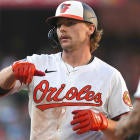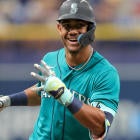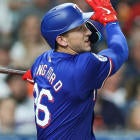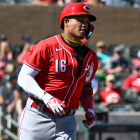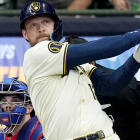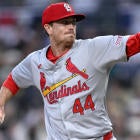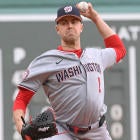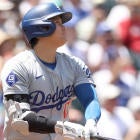
Between Ian Desmond and Anthony Rendon, the Nationals had the most productive left side of the infield in baseball last season. The duo combined for 10.5 WAR via FanGraphs, with 45 home runs and 41 stolen bases between them.
Things haven't been quite so good this season. At third base, at least, they have an excuse, as Rendon's knee injury has kept him out for the first two months. However, Rendon is back from the DL Thursday, and stopgap Yunel Escobar has actually more than held his own, hitting .317/.378/.392 so far. The shortstop situation is a lot bleaker, and there isn't any excuse for that, as health has not been an issue for Desmond.
Desmond is off to a dreadfully slow start, hitting just .246/.293/.379, a disappointing line even for a notoriously slow-starter. Desmond got off to a slow start a year ago, but still had 11 home runs and four stolen bases by this point last season; he has just four and one, respectively, on June 4, 2015.
At least last year, Desmond could point to a .268 BABIP as part of the explanation for his slow start, but that excuse won't fly this season. His .327 mark in that regard is right in line with career norms, and he has actually been able to reduce his strikeout rate following the spike last season. And yet, in spite of those positive signs, he is on pace for the least productive season of his career to date.
Is there any explanation, or reason for optimism? After all, Desmond is just 29, and staring at free agency at the end of the season, so it's hard to believe he has fallen off this poorly. Is there anything in his numbers that Fantasy owners waiting for a breakout can take solace in?
Last season, Desmond became more prone to swing and miss than ever before, especially on pitches out of the strike zone, which causes his overall plate discipline to take a slide. It wasn't that he was necessarily swinging at more pitches out of the strike zone; he just went from making contact on roughly three out of every five out of the zone to a little more than half.
He has righted that to an extent this season, lowering his swinging strike rate to 12.2 percent, per FanGraphs, despite swinging at a higher percentage of pitches thrown his way than any year since 2012. He has improved his contact percentage on pitches out of the zone from 53.5 to 56.0 percent, and his contact rate on pitches in the strike zone has spiked to 89.1, his best rate since 2011.
The problem is, though he is making more contact, he isn't making the right kind of contact. Desmond's groundball rate is up to 56.0 percent, the highest of his career and seventh highest in the majors among qualified hitters. It's hard to hit for power consistently with that many ground balls, and compounding matters is the fact that his hard-hit rate has fallen from 32.4 percent a year ago to just 28.6. He is making more weak contact than in the past, and putting that weak contact in the air less than ever, so it's no surprise Desmond's ISO is all the way down to .133, lower than it has been since 2011.
Even more alarmingly than the lack of thump in his bat might be the complete disappearance of the stolen base from his bag of tricks. Desmond entered this season riding a four-season streak with at least 20 steals, and a lot of his Fantasy appeal came from his 20-20 ability at the shortstop position. However, he has just one through the first 53 games, with only three attempts overall. Rendon's on-base percentage is down to .293, the lowest it has ever been, but even that doesn't really explain the sudden drop-off, as the chart below shows.
| Season | AB | H | 1B% | 2B% | 3B% | HR% | BB% | SBO | SBA | SBA% |
| 2011 | 584 | 148 | 72.97% | 18.24% | 3.38% | 5.41% | 5.50% | 244 | 35 | 14.34% |
| 2012 | 513 | 150 | 60.00% | 22.00% | 1.33% | 16.67% | 5.50% | 180 | 27 | 15.00% |
| 2013 | 600 | 168 | 63.69% | 22.62% | 1.79% | 11.90% | 6.60% | 213 | 27 | 12.68% |
| 2014 | 593 | 151 | 64.90% | 17.22% | 1.99% | 15.89% | 7.10% | 215 | 29 | 13.49% |
| 2015 | 211 | 52 | 61.54% | 30.77% | 0.00% | 7.69% | 5.30% | 89 | 3 | 3.37% |
Given the way his season has gone, some dropoff in his stolen base production would be expected, given how rarely he finds himself on first base. Just 12.7 percent of his career stolen base attempts have come from second base, so the high rate of doubles he has hit could explain some of the dropoff. However, he has been on first or second base with the base ahead of his open 89 times this season, and just hasn't been taking advantage of those opportunities like he did in the past.
Between 2011 and 2014, Desmond attempted a steal 13.9 percent of the time he had an open base ahead of him, a number that has dropped to just 3.4 percent. The fact that he is end up on first base less often than usual -- exhibited by career-low walk rate and lowest 1B percentage since 2012 -- would lead us to expect a lower rate of stolen base attempts, but it can't possibly explain the extent to which he has abandoned the steal.
Strangely, other indicators of speed still point to Desmond not slowing down. He has taken the extra base 63 percent of the time possible, per Baseball-Reference.com, the highest mark of his career by far. He is also scoring 32 percent of the time he reaches base, another career high, and he has been turning groundballs into infield hits at a higher rate than ever before. Even on defense -- where he has been an abject disaster otherwise -- Ultimate Zone Rating actually rates him out as above average for the season when it comes to range. It's hard to find any indication that Desmond has lost a step, except when it comes to his stolen base aggressiveness.
I suppose that is one positive to take from this exercise. If there isn't any reasonable explanation for Desmond's sudden unwillingness to swipe bases, that probably means we can write it off as an anomaly.
The rest of his struggles might not be so easy to brush off, though Desmond is hitting .288/.325/.452 since the start of a 12-game hitting streak May 14. Whether he can continue to parlay that into sustained success as the weather heats up is going to be one of the key things to keep an eye on.
If not, the No. 4 shortstop drafted on average in CBSSports.com leagues before the season could go down as one of the biggest busts of the year.








